From 1 Jan 2010.
I’ve always been bothered by the traditional definitions of seasons, because seasonality is essentially a meteorological phenomenon and these definitions are based on astronomical rather than meteorological events. Clearly the amount of sunlight we receive plays the main role in determining meteorological seasons and hence the astronomical phenomena are important. However, the link between, for instance, the winter solstice and thermal minimum is somewhat complicated. If insolation directly and instantaneously determined terrestrial temperatures, the solstice and thermal minimum should coincide. If we assume a naïve astronomical determinism, winter solstice should be the middle of winter, not its beginning. However, thermal inertia places the temperature minimum after the winter solstice, sometimes long after. Consequently, an astronomically coherent view of seasons does not make sense meteorologically. Placing the beginning of winter at the solstice to account for this lag both removes the astronomical credibility of seasonal definition and entails an assumption that the thermal minimum lags about 45 days behind the winter solstice. This may happen in very cold climates (e.g., the North Slope of Alaska & high elevations in the Sierra Nevada), but more typically the thermal minimum lags 10-30 days after the solstice. The dominant view of seasons as beginning at the solstices and equinoxes does not make sense either astronomically or meteorologically. Like most compromises, it fails on both counts. So, in my opinion, either we should define seasons astronomically, or meteorologically. Since I view seasons as a fundamentally meteorological phenomenon, I will opt for the latter. Perusing weather data for El Paso on wunderground.com, I have defined the seasons for southern New Mexico and west Texas as follows: the coldest 91 days are winter; the warmest 91 days are summer; the days falling after winter & before summer are spring; the days falling after summer and before winter are fall. This gives the following dates:
Spring begins on February 19th.
Summer begins on June 1st.
Fall begins on August 31st.
Winter begins on November 20th.
For comparison, here are graphs showing the various options with temperatures at El Paso (modified from wunderground.com). First, astronomically defined seasons; i.e., solstices & equinoxes are centered in each season:
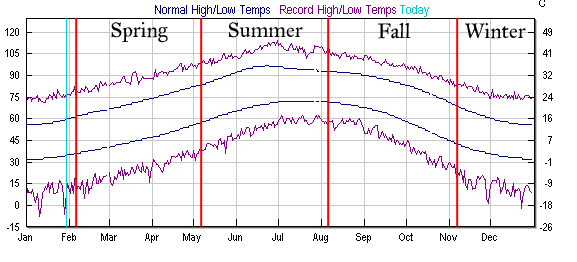
Second, traditionally defined seasons with the solstices and equinoxes beginning seasons:
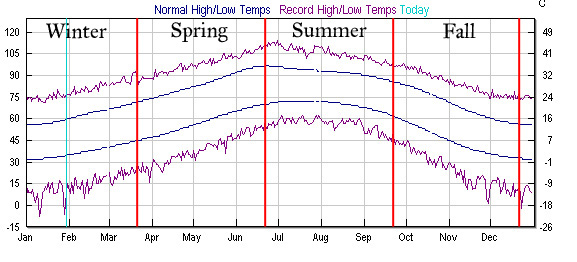
Third, my meteorologically defined seasons:
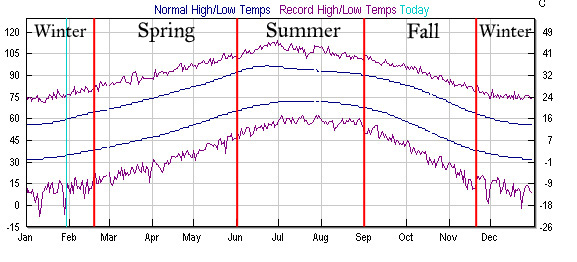
Note that the astronomical seasons are too early (because they do not incorporate lag) and the traditional seasons are too late (because they incorporate too much lag). June 1st and August 30th both have average mean temperatures of 79 degrees Fahrenheit. November 20th and February 18th both have mean temperatures of 51 degrees Fahrenheit. Dates would probably move slightly based on a more precise analysis, but these should be pretty close. Lag for thermal minima and maxima is about 10-15 days, although the thermal maximum is not centered within summer due to the influence of the average onset of monsoonal rains around the beginning of July, which depresses daily maximum temperatures while apparently having no strong effect on daily minima. Spring ends up being longer than fall (102 vs. 81 days), but this reflects the meteorological reality that warming in the area is more gradual in spring than is cooling in fall.
Doing the same thing for Indiana (using weather data from the Indianapolis airport), we get:
Spring begins on March 3rd.
Summer begins on June 5th.
Fall begins on September 5th.
Winter begins on December 5th.
And more graphs; astronomically defined seasons:
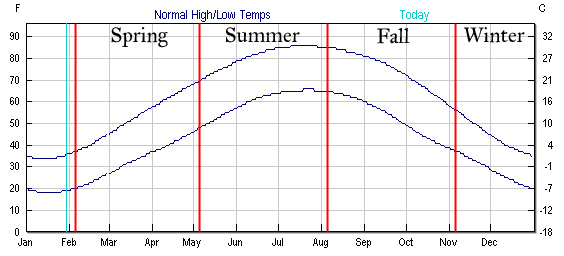
Traditionally defined seasons:
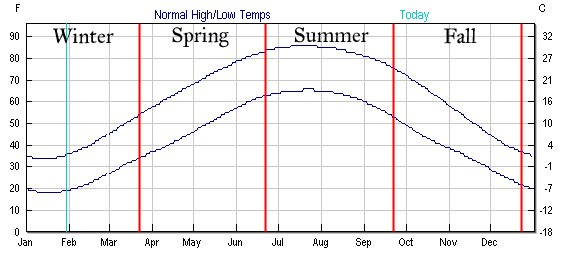
Meteorologically defined seasons:
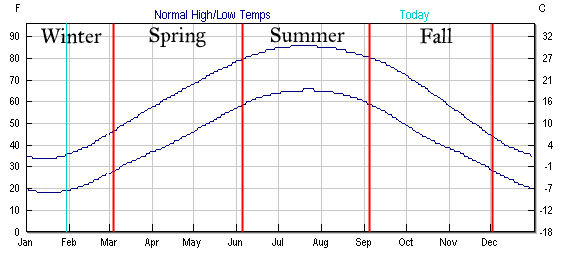
Indiana lacks the significant asymmetry of southern New Mexico & western Texas, presumably because there is no monsoon season. Maxima & minima lag about 28-30 days behind the solstices.
Comparing the two also brings to light another detail worth mentioning: placing the beginnings and endings of seasons at uniform dates across even the climates of the United States is a normative cultural concept that does not accurately meteorological reality. Indiana and southern New Mexico are by no means the most divergent climates one could choose in this respect; I chose them simply because these are the two places I have lived.






